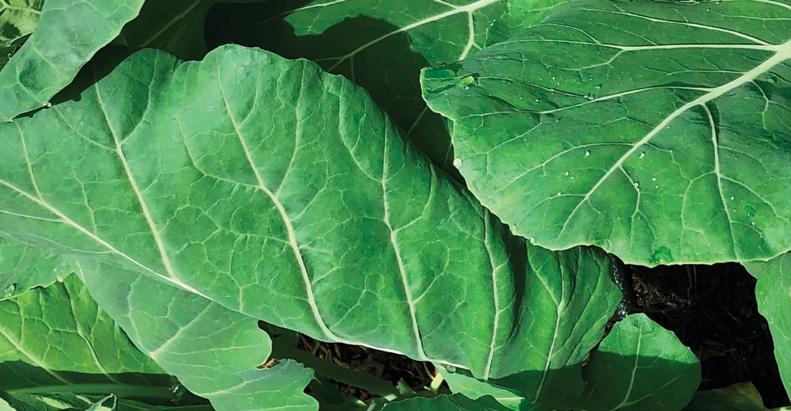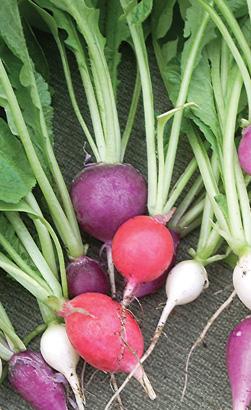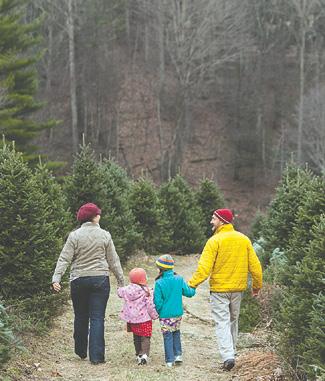
8 minute read
Wisdom and Ways with Jim Casada
WISDOM AND WAYS
Fond Memories of Fall Gardens and Gardening
By Jim Casada


The image of the grizzled, overalls-clad old man seated at the head of a table laden with a scrumptious feast grown and prepared by loving hands resides in my mind’s treasure vaults in powerful, poignant fashion. That old man, my Grandpa Joe, speaking so softly even young ears strained to hear, invited everyone present to bow in prayer while he blessed the food. He always concluded grace with a heartfelt message as telling as the victuals Grandma Minnie had prepared were tempting: “You’uns see what’s before you. Eat hearty.”
As a greedy-gut youngster I had no problem whatsoever in heeding that inviting admonition at any season, but it resonates with particular power when I think of autumn. That was because fall brought the best of two gardening worlds—a bunch of garden vegetables which thrived at that season joining forces with crops which had already “made.” The latter category included pumpkins, candy roasters, possibly a planting of late corn for roasting ears, summer’s final watermelons and what we called mushmelons, hot peppers ready to be pulled up and dried, the last of the tomatoes with prolific “tommytoes” taking pride of place, October beans, and assorted other garden “sass.” But what really tickled my culinary fancy were crops planted in a period between the end of “dog days” and mid-September.
Grandma’s kitchen wizardry produced an array of dishes which came directly from such crops. Meat wasn’t an everyday staple, although many dishes were seasoned with streaked meat and there might be a side serving of that salt-laced delicacy fried crisp. Mainly though the fare was fall vegetables in abundance. For starters there would be “kilt” lettuce with chopped fall onions topped with crumbled streaked meat before piping hot grease from its frying was poured atop the bowl to “kill” the salad. Radishes pulled from the ground not an hour before would accompany the dish. The main menu invariably included a large bowl of what we simply called greens—usually a mixture of mustard and turnips with diced bits of turnip along with roots blended in before the addition of seasoning.
Two other dishes were sure to be present; one commonplace at all seasons while the second was a staple of late fall and winter. These were a pone of cornbread, sometimes liberally laced with cracklings, and pot liquor. Modern folks often refer to the vitamin-rich liquid which accompanies dishes such as greens or boiled cabbage as pot liquor, but the true dish of this designation is chopped cabbage boiled with suitable seasonings such as flakes of dried hot peppers, a slice or two of streaked meat, and perhaps a topping of chowchow when served. Proper pot liquor is thick, tasty, and perfect for “sopping” with cornbread.
Thoughts of those halcyon boyhood days spent knocking on culinary heaven’s gates are closely paralleled by fall gardening recollections. The High Country lies in agricultural Zone 7, which translates to a veritable host of autumn crops growing well, although planting and maturation times, hardiness, whether to rely on seeds or nursery-grown settings, soil types, cultivation, and other factors enter into the overall equation. But the basics are simple and straightforward—there are numerous crops you can grow here which bring health delights and diversity to the fall table.
Among the most popular are favorites already mentioned such as cabbage and traditional mountain greens (mustard and turnips); other types of brassicas (broccoli, cauliflower, Brussels sprouts, and kohlrabi); the various types of leaf land head lettuce; and greens which can be eaten cooked or raw such as spinach, Swiss chard, and kale. Some can withstand appreciable frost and temperatures below freezing, and without exception they can be grown in High Country gardens. I would encourage readers to salute fall by recognizing that for the gardener it can be a time almost as joyous as spring.
Your best answers for what to cultivate and when basically will come from your specific location (micro-climates make a difference), practical experience, input from longtime local gardeners, advice from your local feed-and-seed store, and wisdom of state or federal agricultural agents. Beyond that, here are a bunch of pointers: Get your hands dirty, try new vegetables, experiment with various techniques, and literally learn as you grow.
For any directly seeded vegetable, a few key steps are in order. Make sure the ground is well prepared. Additionally, you can never go wrong with incorporating plenty of humus from a compost pile, mulch you have set aside, or that topsoil you purchased.
Take particular care when sowing tiny seeds, and many fall vegetables fit this description. One suggestion on this front is to mix dry sand with seed to make dispersal a bit easier. Placing this mixture in an old salt shaker with sizeable holes, as opposed to sowing from the palm of your hand will also help. Similarly, cover seeds with care— two inches of soil atop the miniscule seeds of mustard greens merely entombs them. In loose, friable soil, just tamp down seed with the bottom side of a garden rake. Alternatively, consider a sparse sprinkling of topsoil spread by hand along the row or bed after you scatter seeds. Either way, keep soil damp until sprouting, and in this regard an old-fashioned watering can with a sprinkler head comes in handy.
A gentle touch is also required for transplants, which you can start inside, in a shaded spot outside which gets little
Continued on next page
WISDOM AND WAYS
Appalachian Royalty
—Amy C. Millette, Vilas, NC
She respectfully retires her emerald cloak of leaves and dons the vibrant hues of Autumn Rubies, garnets and jasper like fine Murano glass absorb, then release fragments of iridescent light that bounce across her gown in skipping rays of sunlight Embroidery threads the color of imperial topaz deep orange sapphire, translucent citrine quartz blaze like fire weaving intricate patterns of beauty that dance on the surface of her evening attire Poetry Fog settles ever so slightly below her neckline draping a mantle of white silk across the landscape of vivid forested colors shifting its position from the head to her rounded shoulders in ripples of fine woven cloth some parts of her stole so thin they reveal the hazy reflection of her jewel-toned dress And while her shawl settles comfortably into its place the sunset releases one last kiss before the sky is illuminated with diamond-studded stars … Their essence … indescribably brilliant encircling the crown of the Queen’s uplifted head in a tiara of exquisite heirloom gems.
Christmas magic is found on the farm, not in a parking lot.
Make the trek to the Boone & Blowing Rock area in Watauga County to hand pick your family Christmas tree. Many farms offer hayrides, farm animals, cookies and cocoa, and even Christmas Shops where wreaths and roping are also available. Visit the Choose and Cut Capital this season, and start your own family tradition.

To find a farm, visit: wataugachristmastrees.org or call 828.264.3061

YUMMY MUD PUDDLE
264 Clear View Lane, Burnsville, NC
www.yummymudpuddle.com
828.682.6567 John D. Richards, Extremely mixed media Claudia Dunaway, Woodblock prints Kathryn Lynch, Wearables Hot Duck Soup, Novelty Jazz Band
Vacation Rental Available
direct sun, or buy from garden centers. The latter usually have popular plants such as cabbage and broccoli, but for other vegetables or unusual varieties you will likely need to grow your own settings. When transplanting time arrives, and for a week or two afterwards, tender, loving care is in order. Water liberally at the outset and keep the ground moist until transplants are well established. Up to that point a bit of shade, such as having the row next to tall existing plants or maybe covered by some broken tree limbs might be in order.
Likewise, as you move from planting to growth and then maturity, weather will be getting cooler and the likelihood of frost or even a hard freeze increasing. Some plants actually benefit from a bit of frost in terms of taste, but others require protection. If a hard freeze is predicted, precautions such as mulching, black plastic around plants to catch and hold some heat, or covering plants at dusk (be sure to remove the covering the next morning) are in order. With a bit of luck some fall vegetables will continue to yield, especially if harvested on a regular basis to encourage new growth and delay bolting, until the next spring.
Garden pests come in all forms and sizes including invisible problems such as root rot and plant diseases; myriad plantmunching insects; and animal adversaries including rabbits, groundhogs, squirrels, and deer. All, if present in your area, require constant vigilance. Along with fourlegged “friends,” many insect populations peak just as fall vegetables begin to grow well. Cabbage worms, aphids, stinkbugs, grasshoppers, and a host of other pests can do damage in a hurry. Constant checking along with taking immediate action is necessary.
Fall gardening requires gumption, sweaty brows, and attentiveness. But sitting down to a bountifully laden table of the sort my Grandma Minnie provided day after day links you to your forebears in wondrous fashion.

A full-time freelance writer and author of many books, Jim Casada offers a free monthly e-newsletter. To subscribe to it or order his books, visit www.jimcasadaoutdoors.com.










